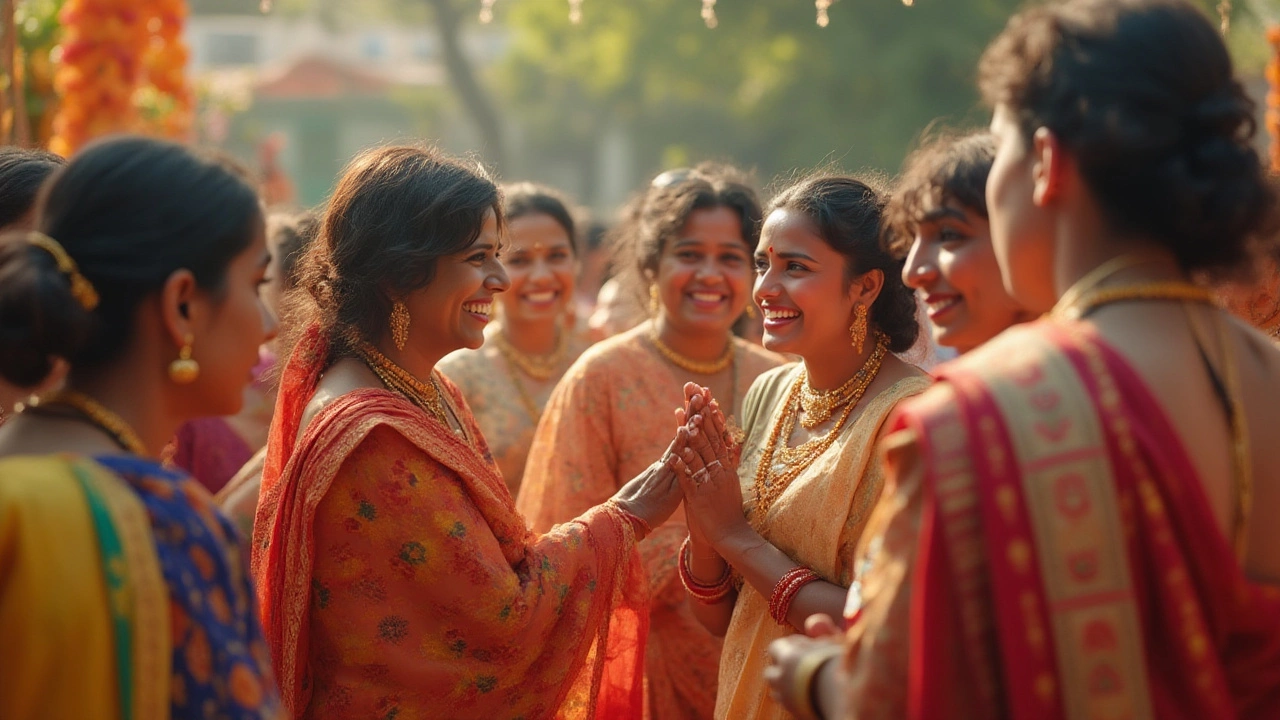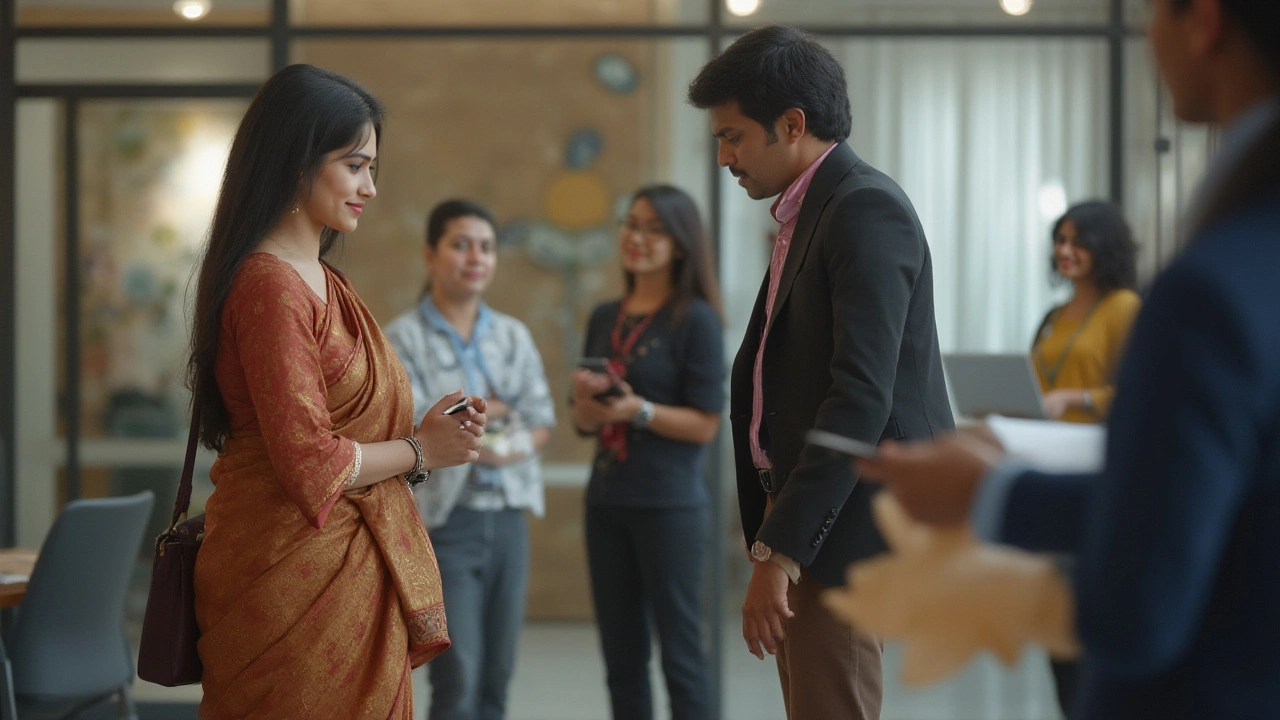How to Greet an Indian Woman: Customs, Dos and Don'ts, and Cultural Insights
 Jul, 5 2025
Jul, 5 2025
Picture this: You’re meeting an Indian woman for the first time—maybe at a friend’s Diwali dinner, in a business setting, or while traveling in India. You want to make a good impression, show respect, and not accidentally do something cringe-worthy. Seems simple, but there’s more to it than just a hello and a wave. Indian greetings are tangled in centuries of tradition, etiquette, and all kinds of what-if scenarios. Miss something, and you risk coming off as clueless—or worse, offensive. Ready to know how to nail that first interaction?
The Heart of Indian Greetings: Respect Drives Everything
If there’s one thread running through Indian greetings, it’s respect—especially when it comes to women. Forget the stereotyped idea of a handshake-for-everyone sort of culture. In India, how you greet depends on a blend of region, religion, age, social context, and sometimes even what time of day it is. For women, the stakes are higher. Personal space matters. What might work in London or New York can feel awkward—or even disrespectful—within Indian settings.
First things first: physical contact isn’t always a default. In many parts of India, it’s not common for men to initiate handshakes with women they don’t know well. Even among urban Indians, especially with elders present, tradition can trump western habits. The safest, most universally respected greeting is the Namaste. Place both palms together, fingers pointing upward, near your chest, and give a gentle bow of the head. It’s simple, elegant, and it communicates respect without crossing boundaries.
What’s fascinating is how deep the roots of ‘Namaste’ go. It literally means “I bow to the divine in you.” The gesture’s not just a hello—it’s loaded with meaning. According to author Devdutt Pattanaik, "The act of folding hands during Namaste is a physical act of peaceful greeting and a way to show humility before another person." You’ll rarely offend with Namaste—it works at weddings, meetings, and even Zoom calls with grandparents. If you’re unsure, this is your go-to move.
The handshake, however, has sneaked into Indian culture, mostly in business or among cosmopolitan circles. But here’s the rule: never initiate a handshake with an Indian woman unless she offers her hand first. Some might prefer it, especially younger, urban professionals. Others might feel uncomfortable. Always watch for cues. If she keeps her hands folded, mirrors your Namaste, or simply nods, follow her lead. When in doubt, skip the handshake.
| Greeting | When to Use | Physical Contact? |
|---|---|---|
| Namaste | Any situation, any woman | No |
| Handshake | Urban, business, if initiated | Maybe |
| Hi/Hello | Informal, close friends | No |
| Touching feet | Traditional, elders | Yes (only by much younger, usually female to elder female) |
Touching feet is another tradition but only between generations (like a daughter-in-law to her mother-in-law) or in very formal religious settings. Never try this unless you really know the tradition—it’s not something to whip out at a first meeting.
The Details: Body Language, Tone, and Unspoken Rules
Ever heard the phrase, “It’s not what you say, it’s how you say it?” That’s pretty much the rulebook for greeting Indian women. Body language speaks volumes. Eye contact? Friendly and respectful, not intense. Smile? Yes, but keep it warm, not overly familiar. Posture? Stand straight but not stiff, don’t slouch or hunch.
Indians are generally not big on dramatic gestures or loud greetings when you first meet someone, especially women. Anything that feels overly enthusiastic (like hugging or air-kissing on each cheek) is a no-go unless you really know the person well and she’s clearly okay with it. Save the bear hug for your college buddy, not someone’s daughter, wife, or colleague you’re meeting for the first time.
Physical space is a thing. Stand at a friendly but respectful distance (about two arm lengths away). Getting too close may feel intrusive; too far and you come across as uninterested. The sweet spot sits right in the middle. If you’re seated, stand up when she arrives. This is subtle, but trust me, it’s noticed and counts as good manners.
Your tone should be polite and neutral at first. Don’t smack your lips or whistle to get attention (both are considered rude in India). Keep your voice pleasant and avoid slang. The classics like "Good morning," "Good afternoon," or "Good evening" are always safe. And if you know the local language, even a simple “Namaste” or “Vanakkam” (Tamil) said with the right intonation gets you instant bonus points.
Region matters. In the south, a slight nod or “Namaskaram” may be more common. In Punjab, people greet with a hearty "Sat Sri Akal"—but use it only if you’re sure about the context. Overdoing local lingo can sound forced.
Lastly, don’t pepper people with questions or compliments as soon as you meet them. Ease into the conversation. Indians appreciate understated, gentle conversation at first. Bombarding someone with questions about their job, family, or personal life right away comes off as nosy. Let the conversation flow naturally.
Here’s a fun fact: According to Pew’s 2022 survey on global etiquette, 87% of Indian women said they feel most comfortable with a Namaste versus any other greeting when meeting new people. That’s a pretty strong hint your safest bet is still the classic folded hands gesture.

Situations and Social Contexts: Formal, Informal, and Everything in Between
The way you greet an Indian woman is not a one-size-fits-all deal. Every context demands a little tweaking. At a business meeting in Mumbai, you might notice your colleague, Aditi, offering a handshake, but her boss, Mrs. Rao, waiting for you to initiate Namaste. At a family event in Delhi, everyone’s greeting grandma with “Pranam” and folded hands, but your friend’s younger sister just says “Hi!” and that’s totally cool too. Context is everything.
- Formal business: Always play it safe with Namaste. Watch for cues—a few companies now have Westernized etiquette, but traditional ones still prefer no touch. If she offers her hand, take it, but no aggressive gripping or shaking.
- Festivals and family events: When visiting someone’s home during Diwali, Holi, or Eid, greet the oldest women first, with Namaste or Pranam if you know the household is traditional. Don’t offer handshakes unless prompted. With younger family members or friends, a nod, smile, or casual “Hi” does the job.
- Social outings and parties: Urban meetup? In circle of close friends, casual greetings work: "Hey!" or "Hi!". Minimum body contact is still appreciated; handshakes only if initiated. Never try cheek-kissing or hugs out of the blue.
- Religious or rural settings: Here, tradition rules. Any form of physical touch can feel uncomfortable or outright taboo. Always default to Namaste or the local equivalent. It’s better to be called stiff than stepping on cultural toes.
Here are a couple of common mistakes people make: assuming every Indian woman will react the same way and mistaking Western Indian cities (like Bangalore or Mumbai) as completely modern where anything goes. Cultural norms move slowly. If aunties are around, or if you’re not sure, stick with the classics.
How about digital greetings? Sending a message on WhatsApp or email? “Namaste” is still the most polite way to begin, especially on festivals or formal occasions. Younger women may use “Hi” or “Hey” for friends, but older generations prefer traditional respect, even online.
What Not To Do and Why It Matters: The Don’ts of Greeting Indian Women
Screwing up a greeting can put your whole interaction on the back foot. Some things are near-universal no-nos and can quickly make you look culturally unaware. Here are a few traps to watch out for, and why they matter.
- Don’t lean in for hugs, kisses on both cheeks, or back pats unless you are close friends and she clearly goes first.
- Don’t initiate handshakes unless she offers. Forcing a handshake is awkward for both parties, and can be seen as domineering.
- Never address any Indian woman by her first name in front of older relatives unless invited to do so.
- Flirting at first meeting is a disastrous move. Indian culture is still largely conservative about male-female dynamics—save cheeky winks for a later day.
- If you see women wearing traditional attire (like saree or hijab), always default to Namaste. It’s a strong sign of cultural or religious families.
Here’s a data bite for you: According to a 2021 LinkedIn poll among Indian HR professionals, 62% said they’ve coached international colleagues not to go for a handshake first when greeting female staff—awkward moments do happen, even in the most corporate spaces.
Sometimes it’s tempting to play it cool and act familiar, but Indian women, especially in traditional settings, appreciate formal boundaries. It’s actually seen as a sign of your upbringing (what Indians call ‘sanskars’). Good etiquette shows you’re thoughtful, and that always leaves a better impression than trying too hard to fit in with overly casual moves.
As Indian actress Deepika Padukone once said:
“Respecting boundaries—physical and emotional—is the most attractive quality. A genuine Namaste speaks louder than words.”
Want some quick tips that always work?
- Namaste never offends. Use it when in doubt.
- Keep your smile warm but not overly familiar.
- Stick to businesslike body language in formal settings; relax a bit with friends, but only as far as is comfortable for her.
- Mirror her greeting style—follow her lead.
- Never bring up jobs, marriage, or other personal questions in your first greeting. That can wait.
So next time you meet an Indian woman, don’t stress about getting every single cultural code right. The basics—respect, politeness, reading her cues—matter way more than knowing the intricacies of every region or religion. Almost everyone appreciates genuine intentions, and that classic Namaste gesture is always your safest bet.